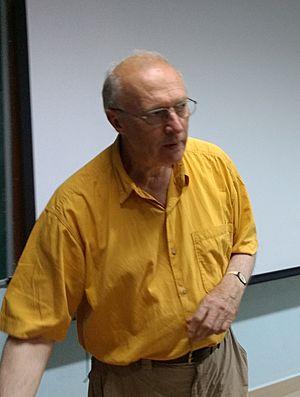Malcolm Burrows facts for kids
Quick facts for kids
Malcolm Burrows
|
|
|---|---|

Speaking at the department of entomology in the University of Agricultural Sciences, Bangalore (2017)
|
|
| Born | 28 May 1943 Luton, Bedfordshire, England
|
| Alma mater | Jesus College, Cambridge |
| Occupation | University lecturer |
| Known for | The Neurobiology of an Insect Brain (1996) |
| Awards | Frink Medal (2004) |
| Scientific career | |
| Fields | Zoology |
Malcolm Burrows is a British scientist who studies animals, especially how their brains control their movements. He was born in Luton, England, on May 28, 1943. He became a professor of zoology at the University of Cambridge.
His work often looks at how tiny creatures like insects use their nerves and muscles. He studies how they make quick jumps and other fast movements.
Contents
Malcolm Burrows' Scientific Journey
Malcolm Burrows began his studies at Jesus College, Cambridge in 1961. He earned his PhD by studying how animals move. Later, he worked on different projects, including how mantis shrimps strike and how crabs use their mouthparts.
He also spent time at the University of Oxford, studying how locusts move. Eventually, he returned to Cambridge. He was an editor for an important science magazine called the Journal of Experimental Biology.
Awards and Retirement
In 2004, Malcolm Burrows received the Frink Medal. This is a special award given to zoologists in the United Kingdom. He was the head of the zoology department at Cambridge for 15 years. He retired from this role in September 2010.
Discoveries About Insect Movement
Malcolm Burrows is well-known for his research into how insects move. He has studied the tiny parts inside insects that help them jump and move very quickly.
The Jumping Bug Mystery
In 2013, Malcolm Burrows and Gregory Sutton made an exciting discovery. They found out how young Issus bugs jump. These tiny bugs use a special gear-like mechanism in their legs. This helps them jump with incredible speed and power.
This discovery was very important because it showed that nature can use mechanical gears. Before this, scientists thought gears were only found in human-made machines.
Studying Insect Jumps
Malcolm Burrows has written many scientific papers about his findings. Some of his work includes:
- How froghopper insects control their jumps.
- How froghoppers can jump to amazing heights.
He also wrote a book in 1996 called The Neurobiology of an Insect Brain. This book explains how an insect's brain works.

